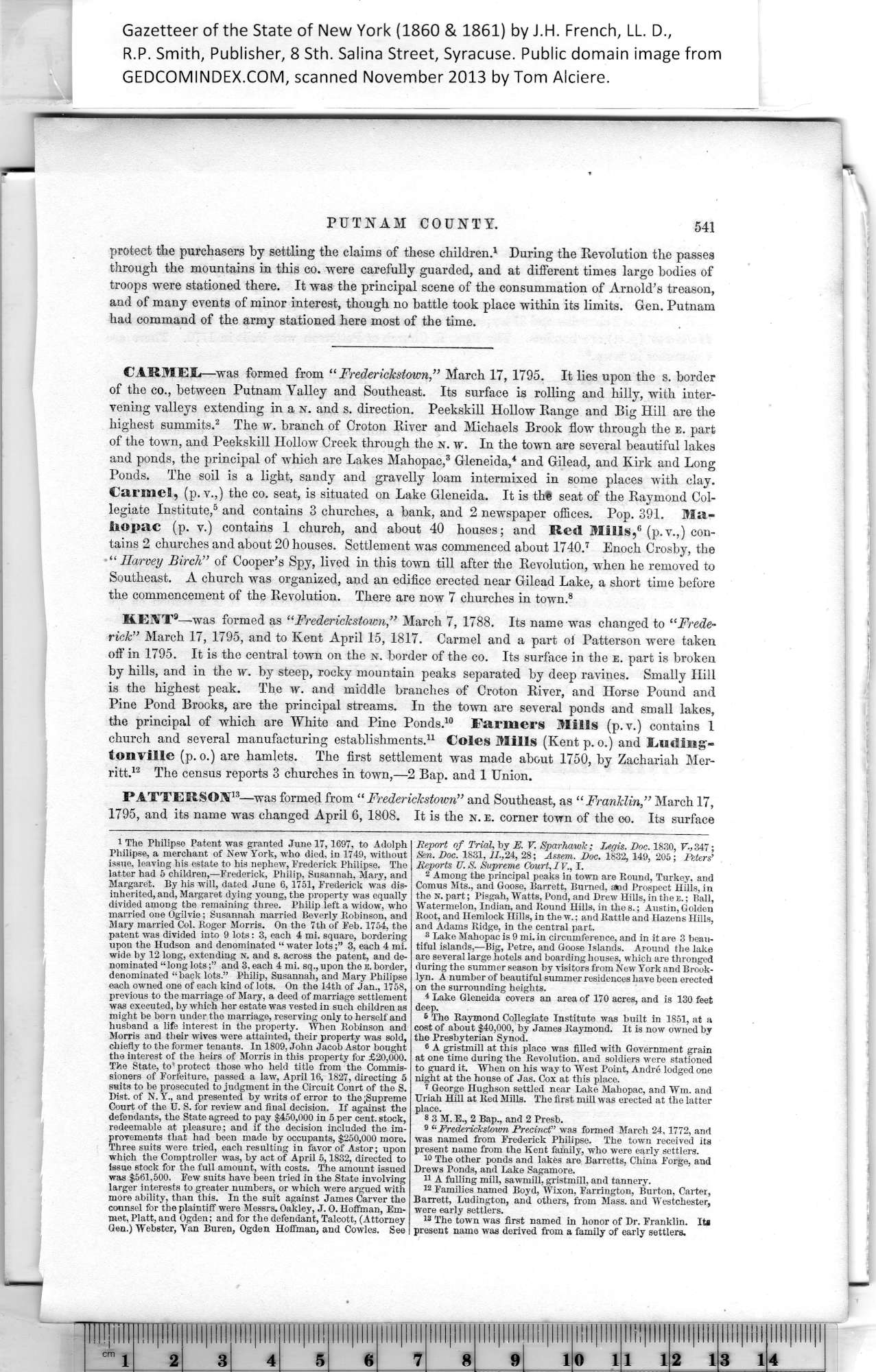|
PUTNAM COUNTY. 541
protect the purchasers by settling the claims of these children.1 During the Revolution the passes
through the mountains in this co. were carefully guarded, and at different times large bodies of
troops were stationed there. It was the principal scene of the consummation of Arnold’s treason,
and of many events of minor interest, though no battle took place within its limits. Gen. Putnam
had command of the army stationed here most of the time.
CARMEL—was formed from “Frederickstown,” March 17, 1795. It lies upon the s. border
of the co., between Putnam Yalley and Southeast. Its surface is rolling and hilly, with inter¬
vening valleys extending in a n. and s. direction. Peekskill Hollow Range and Big Hill are the
highest summits.2 The w. branch of Croton River and Michaels Brook flow through the e. part
of the town, and Peekskill Hollow Creek through the n. w. In the town are several beautiful lakes
and ponds, the principal of which are Lakes Mahopac,3 Gleneida,4 and Gilead, and Kirk and Long
Ponds. The soil is a light, sandy and gravelly loam intermixed in some places with clay.
Carmel, (p.v.,) the co. seat, is situated on Lake Gleneida. It is the seat of the Raymond Col¬
legiate Institute,5 and contains 3 churches, a bank, and 2 newspaper offices. Pop. 391. la-
Iiopac (p. v.) contains 1 church, and about 40 houses; and Red Mills,6 (p.v.,) con¬
tains 2 churches and about 20 houses. Settlement was commenced about 1740.7 Enoch Crosby, the
“ Harvey Birch” of Cooper’s Spy, lived in this town till after the Revolution, when he removed to
Southeast. A church was organized, and an edifice erected near Gilead Lake, a short time before
the commencement of the Revolution. There are now 7 churches in town.8
KENT9—was formed as “Frederickstoivn,” March 7, 1788. Its name was changed to “Frede¬
rick” March 17, 1795, and to Kent April 15, 1817. Carmel and a part of Patterson were taken
off in 1795. It is the central town on the n. border of the co. Its surface in the e. part is broken
by hills, and in the w. by steep, rocky mountain peaks separated by deep ravines. Smally Hill
is the highest peak. The w. and middle branches of Croton River, and Horse Pound and
Pine Pond Brooks, are the principal streams. In the town are several ponds and small lakes,
the principal of which are White and Pine Ponds.10 Farmers Mills (p.v.) contains 1
church and several manufacturing establishments.11 Coles Mills (Kent p. o.) and Luding-
t oil Ville (p. o.) are hamlets. The first settlement was made about 1750, by Zachariah Mer¬
ritt.12 The census reports 3 churches in town,—2 Bap. and 1 Union.
PATTERSON13—was formed from “Frederickstown” and Southeast, as “ Franklin,” March 17,
1795, and its name was changed April 6, 1808. It is the n.e. corner town of the oo. Its surface
|
Report of Trial, by E. V. Sparhawk; Legis. Doc. 1830, FT, 347;
Sen. Doc. 1831, II.,24, 28; Assent. Doc. 1832, 149, 205; Titers’
Reports U.S. Supreme Court,IV., I.
2 Among the principal peaks in town are Round, Turkey, and
Comus Mts., and Goose, Barrett, Burned, and Prospect Hills, in
the n. part; Pisgah, Watts, Pond, and Drew Hills, in the e. ; Ball,
Watermelon, Indian, and Round Hills, in the s.; Austin, Golden
Root, and Hemlock Hills, in the w.; and Rattle and Hazens Hills,
and Adams Ridge, in the central part.
3 Lake Mahopac is 9 mi. in circumference, and in it are 3 beau¬
tiful islands,—Big, Petre, and Goose Islands. Around the lake
are several large hotels and boarding houses, which are thronged
during the summer season by visitors from NewYork and Brook¬
lyn. A number of beautiful summer residences have been erected
on the surrounding heights.
4 Lake Gleneida covers an area of 170 acres, and is 130 feet
deep.
3 The Raymond Collegiate Institute was built in 1851, at a
cost of about $40,000, by James Raymond. It is now owned by
the Presbyterian Synod.
6 A gristmill at this place was filled with Government grain
at one time during the Revolution, and soldiers were stationed
to guard it. When on his way to West Point, Andre lodged one
night at the house of Jas. Cox at this place.
I George Hughson settled near Lake Mahopac, and Wm. and
Uriah Hill at Red Mills. The first mill was erected at the latter
place.
3 3 M. E., 2 Bap., and 2 Presb.
8 Frederickstown Precinct” was formed March 24,1772, and
was named from Frederick Philipse. The town received its
present name from the Kent family, who were early settlers.
to The other ponds and lakes are Barretts, China Forge, and
Drews Ponds, and Lake Sagamore.
u A fulling mill, sawmill, gristmill, and tannery.
18 Families named Boyd, Wixon, Farrington, Burton, Carter,
Barrett, Ludington, and others, from Mass. and Westchester,
were early settlers.
13 The town was first named in honor of Dr. Franklin. Its
present name was derived from a family of early settlers. |
|
